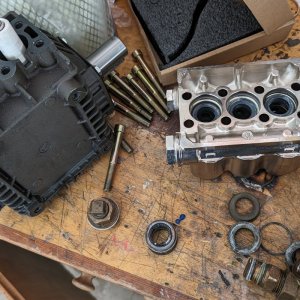An engine's horsepower is a poor factor onto which to base a conclusive determination as to whether it will work for a particular blower. First, every engine's horsepower rating, if accurate, is the power output at redline. Redline is almost never the speed at which TM is going to operate its engine.
More likely, the engine will run its blower at top speed at or near the peak of the torque curve. Torque specifications vary somewhat for engines that can have the same horsepower. Therefore, a particular horsepower spec may be just fine for a given blower, but another engine with the same horsepower output may not work at all for a particular load set.
There are no shortcuts to examining the characteristics of an engine on a case by case basis and seeing if it will provide enough power at the desired speed(s) of the driven blower and pump combination and their desired outputs.
Other factors which can also come into play are the means by which an engine will be coupled to the blower and pump. When a direct coupler is used, the drive/driven ratio is always 1:1, which may produce limitations for the applicability of a particular engine. Sometimes you can gain latitude or "breathing room" in engine applicability in a drive system that does not constrain you to a 1:1 ratio, such as with belts and sheaves. But belts themselves have their own parasitic losses that direct drives do not.
I know it sounds rather complex, and sometimes it is even more so. Perhaps on paper and engine seems like it would work perfectly, and then in practice you find that things like operating temperature at a particular load don't mesh with your unit's physical design or cooling characteristics.
Often, manufacturers will take the really easy approach and "supersize" their engine choice, negating possible conflicts of insufficient power. This "supersizing" also has potential positive side benefits, such as greater BTU generation for a Heat Exchanger based heating system for the solution. In most cases specifying just a couple of horsepower over what might be "enough" is plenty for a particular blower size. That is why most 20 HP engines will work just fine for a #4M blower, when even a select few engines a couple of horsepower less might do also. But in reality it is become less rare that you see some lower HP engines producing
superior torque to an engine with higher hosepower. This is because engines themselves are becoming more universal in design to meet emission regulations (e.g. you don't see many stroker L-head engines anymore).

